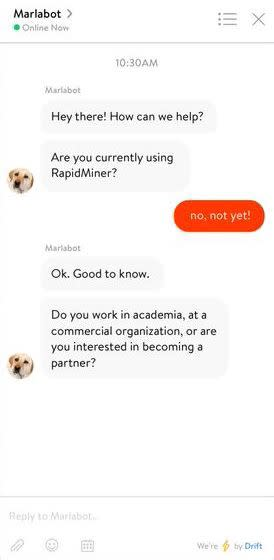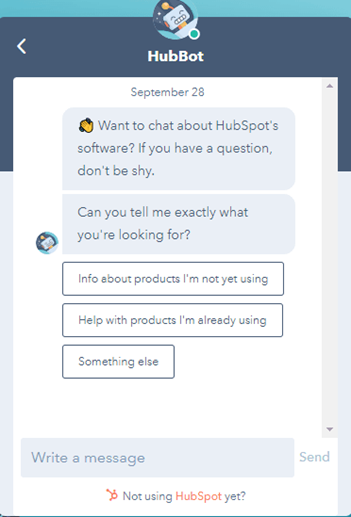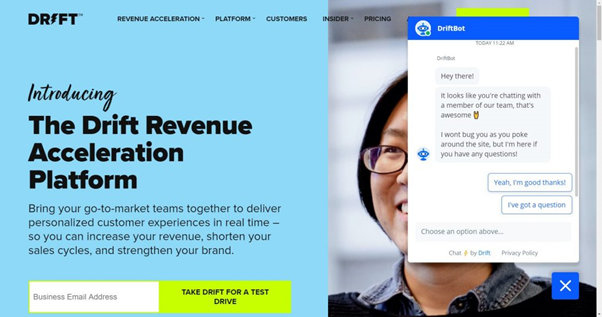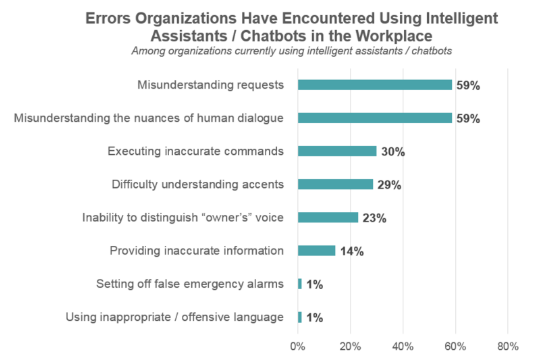Chatting, the most human thing to do. Have a natter with your nan. Have a discussion with your dad. Have an argument with your aunt. Have a parley with your...postman. You get the idea. So why have B2B businesses been turning to robots in recent years?

There's no doubt that chatbots have continued to grow in popularity over recent years. In fact, the global conversational AI market is poised to grow $13.9B by 2025.
The wide use might be due to the promise of their wide use; a chatbot can be leveraged in a number of different ways. From collecting information, qualifying leads, booking product demos, engaging website visitors, to facilitating a faster sales cycle, a chatbot seems like a quick and effective fix.
Plus, chatbots seem to fit perfectly with the new B2B buyer. According to research by Forrester, 68% of B2B buyers prefer to collect information online independently rather than interacting with a sales rep.
This behavioural shift presents new challenges, especially in how to engage website visitors in a personalised way. After this independent research, your prospects will drift towards your site, which will be the next point of contact for these buyers' research. So, it's all about first impressions.
A chatbot, in this scenario, means quick questions answered, and tailored content provided, without putting strains on your team.
But are chatbots the best way to do it, especially with the burgeoning technology occasionally being spotting at best, and harmful at worst?
With all these benefits noted, we have to ask:
Why are most B2B chatbots underperforming?
Okay, okay. It's not all as bad as I'm making it out to be. Chatbots aren't living up to the expectations they generated (but then what does), but this is less to do with the tech itself, and more to do with how it's being used.
Chatbots do have the potential to be extremely useful in the way customers and companies interact, in terms of the initial stages and purchasing. But this can't happen as smoothly as needed until more bots are created that simply want to solve user issues.
Lots of developers go for novelty and flashy features, and forget the user experience. B2B customers, though beginning to overlap with the desires of B2C, still want a pleasant, novelty-free, and straight-forward customer experience.

B2B industries don't tend to adopt tech as quickly as B2C. In fact, many B2B employees tend to call a contact they have an existing relationship with, in order to sort issues they have. So, introducing chatbots into this might be confusing. What may happen in the near future is the unification of live chat and bots - at least until people get more familiar with the technology.
The thing is, though this sounds the best of both worlds, it takes away from the biggest benefit of chatbots i.e. freeing up your team.
And at this point, there is a real need for human support. Even the most sophisticated machine learning produces a 85% accuracy rate for chatbot responses, and many enterprise solutions perform way below this. And B2B sales relies on this accuracy.
Without getting a satisfying answer, the user feels as if their time has been wasted.

Plus, bots trained on publicly available data can run into some...issues.
For example, Microsoft bot Tay was modelled to talk just like your average teen. But her gen-z friendly language quickly turned sour, shifting to hate speech within a day. The company had to take her offline, and apologised that they had not prepared the bot for the coordinated attack from Twitter users.
Chatbot tech may also be inaccessible for any company without masses of resources. Enterprises are making good progress with the tech, with 40% of large businesses being expected to implement over the coming years. But small businesses are not having good enough results to make chatbots worth the effort.

Articulate, who introduced a chatbot onto their site, reported their findings.
"As a small B2B business that relies almost entirely on our inbound marketing efforts, the impact on site performance was not worth the results we saw. In fact, its presence likely harmed our other lead generating efforts." said Matthew Stibbe, CEO of Articulate Marketing.
They also found that:
- The chatbot underperformed in terms of conversion rates - 0.2% on chat, compared to 0.5% for the site as a whole.
- Of the 24 contacts on their list during the test period, only a small handful were non-webmail addresses, and none were qualified leads.
- The chatbot increased the page weight by 25%
- The load time doubled overall
- Their Google PageSpeed score for mobile moved into the red.
As a result, they switched off their chatbot.
Basically, the creation and implementation of chatbots is still in it's relative early stages. Chatbots rely on language processing, which means that it can be restricted by accents and mistakes.
They're also unable to deal with multiple questions at the same time, so conversation opportunities are limited. Plus, they require a large amount of conversational data to train - something that might not be available to small or medium sized businesses.
…But it's not all bad news.
Chatbots do have their benefits, even if they aren't yet living up to the hype.
Using an AI chatbot for website communication does tend to reduce friction, increase engagement, and smooth marketing-to-sales handoff.
Though, as Articulate has proved, this tends to be where chatbots fail. So, it might be useful to think of chatbots in a different way - as insight providing tech. Chatbots can provide businesses with information surrounding:
- Site navigation enhancements
- Contact qualification
- Conversion and nurturing opportunities
So, let's have a look into a few B2B businesses that are playing the chatbot game in the right way.
1. RapidMiner - Lead Generation for Sales
RapidMiner, a Data Science & Machine Learning Platform, chose to use a "sales assistant" developed by Drift to provide a lead generation service for their sales team.
Visitors to their site are greeted by MarlaBot, who begins the conversation a few moments after the user lands on the site, running up to them like your average Lush Store employee.

Plus, Marla has backup - RapidMiner sales staff are brought in as soon as the bot gets an answer, and monitor the conversation to see when they should jump in. The 'best of both worlds' technique coming into full force, but only when it's needed. This means the team can get on with their job, until the right moment.
“The bot isn’t about replacing a human. The bot for us is about augmenting and taking a user down a journey so then we can jump in at the right moment.”
– Tom Wentworth, Chief Marketing Officer at RapidMiner
On top of this, Marla collects all the data needed from the interactions, in order to build a more relevant and personalised experience for each user. The bot is even able to handle the entire conversation by itself in many cases.
“One of the most common responses we get at the end is ‘thank you’," continues Tom. So, Marla has become so integrated into the buying journey, that customers thank her as if she were a real sales rep.
2. HubSpot – Product FAQ
B2B is the big chatbot name on the block. The marketing software platform even acquired Motion.ai waaaaaaaaaay back in 2017 in order to add the ability for clients to build, train, and deploy chatbots.
Hubspot has a website and a Facebook Messenger bot that it uses to capture leads and provide users with more info on its software.

The bot, like Marla, acts as a placeholder until a live rep can jump in to chat. But first, the bot will ask users what help they are looking for, so they can be identified as either a prospect or current customer. This means the human can be informed when they are taken off the subs bench.
The Facebook bot is used to drive users to their website, as well as towards the blog subscriptions. Users can sign up for blog alerts through the social media platform.
The convenience of this process shows that HubSpot is using their chatbot to provide a smooth user experience.
3. Drift - Account Based Marketing
Drift has perfectly designed their chatbot to fit their ABM campaign. The chatbot knows when the visitor has interacted with a member of the Drift team, and also offers assistance if the user needs any further help. So, Drift are able to keep an eye on the user's behaviours and attentions on the site, and provide a useful response.

This adds to the personalised, attentive experience Drift hope to provide with their ABM campaign. Though this level of attention might be slightly unnerving in other cases, with ABM it works. Using this tech has allowed Drift to better target customers, and minimise duplicate communications.
Drift doesn't just do ABM chatbots however. They also use it to convert users who click through their paid ads. This chatbot only shows up when visitors come through a paid Google ad.
Using this information, the chatbot can make assumptions on why the customer is on the site, their desires and pinpoints.


